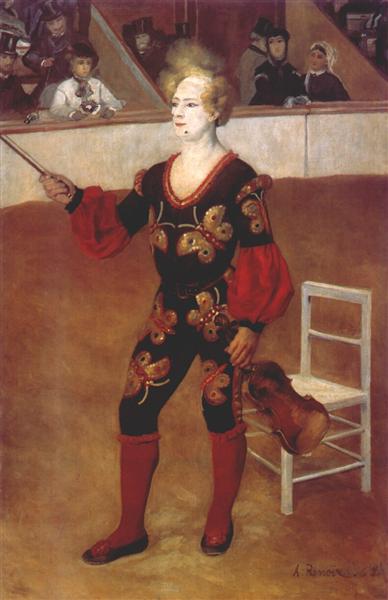Beskrivelse
Pierre-Auguste Renoir's painting "The Clown" (1868), also known as "The Clown (James Bollinger Mazutreek)", is a work that captures the essence of 19th-century party culture and fascination with entertainment. Evoking a strong emotional connection, this portrait falls within the context of Renoir's artistic transition towards a more expressive use of colour and light. The work features a clown, a symbol of joy and fun, who becomes the centre of attention with his intense and enigmatic gaze.
The clown, dressed in a colorful costume that includes vibrant patterns and a wide painted smile, is presented in a pose that suggests both joy and sadness, revealing the duality of his existence. The choice of the clown as the protagonist is not accidental. This figure represents the character who, behind his mask of happiness, often occluded a sense of melancholy, thus reflecting the complexities of the human condition. Renoir captures this emotional transience, a recurring theme in his work, through the clown’s expression, which seems to be somewhere between an act of fun and deeper introspection.
The composition of the work reveals a meticulous attention to the organization of space. The clown is placed in the foreground, occupying most of the canvas, while the background is blurred into softer, less defined colors, allowing the central figure to stand out. This technique is characteristic of the Impressionist style, which relies on visual perception and light, emphasizing atmosphere rather than minute detail. Renoir uses loose, gestural brushstrokes that bring the painted surface to life, creating a sense of immediacy and movement.
The use of colour is another fundamental element in the work, with a rich and varied palette that combines warm and cool tones. The vivid reds and bright yellows of the clown's costume contrast with the softer hues of the background, which not only highlights the central figure, but also infuses the scene with energy. The light seems to dance across the surface, suggesting a spontaneity that is characteristic of Renoir's style. This ability to capture light and colour would become one of the hallmarks of his career, influencing many of his later works.
Throughout his career, Renoir explored diverse themes, from everyday life in Parisian society to nature scenes and intimate portraits. "The Clown" is a clear example of his desire to capture not only the external image but also the essence of the human being through painting. Compared to other works of his time, this painting can be seen in dialogue with other representations of the figure of the clown in art, which often symbolizes the paradox of joy and sadness.
In short, The Clown is a clear testament to Renoir's mastery of emotional representation through light and color. His ability to make a simple clown a spokesperson for the complexity of human emotions is what makes this work a valuable example of Impressionism, as well as a reminder of the depth that can be found in the most seemingly simple figures of everyday life. The work, although less known than some of his most iconic paintings, deserves to be observed and appreciated not only for its aesthetics, but for the rich interpretation it proposes of the human experience.
KUADROS ©, a famous painting on your wall.
Hand-made oil painting reproductions, with the quality of professional artists and the distinctive seal of KUADROS ©.
Painting reproduction service with satisfaction guarantee. If you are not completely satisfied with the replica of your painting, we will refund 100% of your money.

